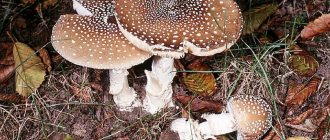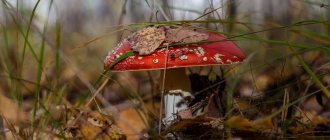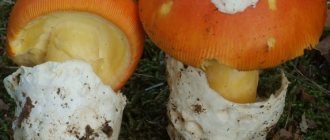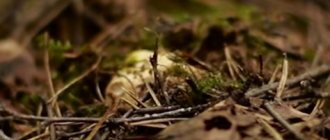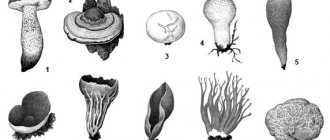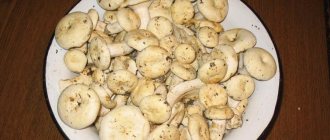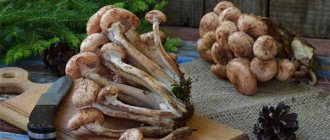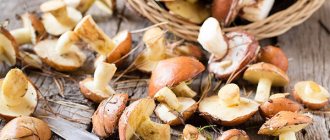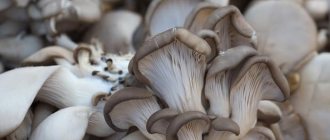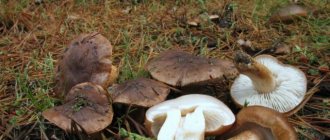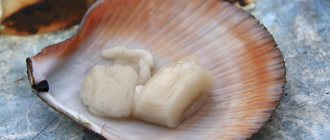Red fly agaric (Amanita Muscaria) is a poisonous mushroom with psychoactive effects. It belongs to the genus Amanita or Fly Agaric. The name fly agaric is associated with the ancient method of its use as a means of repelling flies. Despite its notoriety, red fly agaric is widely used in folk medicine, cosmetology and farming.
Appearance
The appearance of the red fly agaric is represented by a cap and a leg. The diameter of the cap ranges from 8 to 20 centimeters. The shape of young mushrooms is predominantly semicircular. With age, the cap becomes flat and sometimes concave. A distinctive feature of the red fly agaric is the color of the cap, which varies in different shades of red. In young mushrooms, the color of the cap is most often bright red, in old ones it is light orange. With age, the cap becomes duller and lighter. The surface of the cap is covered with characteristic white flakes. Old mushrooms may not have them, as they are easily washed away by rain. The plates under the cap are located freely with the presence of intermediate plates. Their color is white, but they turn yellow or brown as the mushroom grows.
The length of the mushroom stem can reach 30 centimeters with a diameter of 1 to 2.5 centimeters. The shape is cylindrical with a tuber-shaped thickening at the base. The color of the stem is white, but may turn yellowish. Old mushrooms have a completely hollow stem. Not far from the leg there is a membranous ring with a brownish tint. However, in mature mushrooms the ring is quite difficult to distinguish, since it merges with the stalk.
The spore-bearing layer is represented by a tubular texture, white in young mushrooms, yellow in old ones. The pulp is white. When in contact with air it acquires a yellowish tint. The taste is sweetish, but has virtually no odor. The spore powder is white, the spores themselves have a distinct ellipsoidal shape.
Growing area
You can meet the red fly agaric in deciduous and coniferous forests, as well as in meadows, fields and parks. It inhabited a very large area. Distributed in all forests of Russia, with the exception of the southern regions with a dry climate. The fruiting period begins in June and ends in early November. Prefers to grow in acidic soils. Often found under forest spruce and birch trees. It most often grows in groups, but can be found singly.
History of appearance and habitat
The first mention of the mushroom appeared in 1256. Then the scientific name was different - “fly mushroom”. The name was given because the fly agaric had the ability to get rid of flies. Because of the destructive smell, the insects quickly died. But this is just an assumption, in reality everything is not so. A lot of water containing alkaloids accumulates in the cap. If flies drink it, they will fall asleep and may simply drown in the liquid.
You can meet the red fly agaric anywhere - deciduous, mixed, coniferous forests. Most of all they like to settle on spruce or birch trees, this is where the acidity of the soil is high. They grow next to boletus, russula, boletus and other varieties of mushrooms.
Amanita mushrooms grow from early summer to mid-autumn. Found alone or in small groups. In Russia you can see it in almost every grove and forest. Since fly agarics are poisonous, they can only be collected for medicinal purposes.
Virulence
The danger of the red fly agaric is due to the high concentration of various poisons in its composition. When consumed, the parasympathetic nervous system is seriously affected. The chemical composition of the red fly agaric contains poisons such as:
- muscarine;
- choline;
- bufotenine and betaine (responsible for the hallucinogenic effect);
- putrescine;
- ibotenic acid (irritates mucous membranes).
A person only needs 5 grams of red fly agaric in its pure form to receive a lethal dose of a large number of toxic substances. In combination with alcohol, poisons act many times faster and affect organs in a very short time.
According to one theory, ibotenic acid, contained in red fly agarics, kills various insects. However, using it indoors with people and pets is extremely dangerous. During drying, the mushrooms release bufotenin and betan, which have a hallucinogenic effect. These substances can cause seizures.
Red fly agaric poisoning
Ibotenic acid penetrates the brain tissue, acting as a hallucinogen. Possessing extremely high neurotoxicity, ibotenic acid leads to the death of brain neurons. Muscarine leads to a decrease in cardiac output and dilatation of blood vessels, as a result of which blood pressure drops significantly, vomiting and nausea appear, saliva production increases, and bronchospasms begin. Muscimol has a dissociative and sedative-hypnotic effect.
Red fly agaric poisoning occurs quite rarely. Most often it is associated with the incorrect use of the mushroom for medicinal purposes. The first symptoms appear a couple of hours after eating red fly agaric. These include: weakness, vomiting, nausea, headache and dizziness, vision problems, increased body temperature, hallucinations and bradycardia. Death from poisoning is quite rare, but the victim requires urgent medical attention. Before doctors arrive, it is recommended to drink plenty of fluids. It is also worth trying to flush the stomach by vomiting. To relieve symptoms, you can drink activated charcoal. This way you can prevent toxins from entering your intestines. The doctor selects the required dose of the antidote anthropine to treat poisoning.
Self-medication will not lead to good consequences, therefore, at the first signs of poisoning, you must urgently seek the help of professional doctors.
Contraindications
Fly agaric infused with alcohol has a number of contraindications:
- not recommended for children under 18 years of age, pregnant women and during lactation;
- also harmful for dysfunction of the cardiovascular system, kidneys, liver and mechanical damage to the dermis (skin).
You can drink the tincture only in strictly defined dosages. Excess leads to serious poisoning or causes unpleasant side effects:
- increased salivation;
- nausea, vomiting;
- stool disorder;
- increased excitability of the central nervous system;
- dizziness, confusion;
- auditory and visual hallucinations;
- heavy sweating;
- The pupils dilate and then become very constricted, and the victim loses consciousness.
When applied topically, alcohol tincture can cause a burn.
If you notice symptoms of poisoning, call an ambulance. Give the victim a liter of water mixed with a packet of Regidron and try to induce vomiting again.
Use for medicinal purposes
The red fly agaric cap has a unique value. These mushrooms also contain a large amount of fiber and enzymes, which allow you to effectively break down fats and glycogen. Red fly agarics are actively used in the treatment of cancer, radiation ulcers and dermatitis. In pharmacology, the active substances of the red fly agaric are used to produce medicines that effectively fight angina pectoris, heart pain, increased heart rate, arrhythmia and hernias.
Traditional medicine actively uses various decoctions of this mushroom to treat diseases in the spinal cord, alcoholism, goiter and depression. To restore joints and treat radiculitis, tinctures of red fly agarics are used.
In homeopathy, red fly agarics received special recognition two centuries ago. The homeopathic medicine Akarikus is based on an extract from the red fly agaric. The drug was used to combat diseases such as parkinsonism, seizures, bladder paralysis and muscle spasms.
Red fly agaric is actively used in cosmetology. Extracts without toxic substances are created from mushrooms. As a result, the extract contains a whole complex of enzymes and active antioxidants. It is used to increase elasticity and firmness, smooth the surface of the skin, and stimulate cell renewal.
To combat insects, special formulations are created using the cap of the red fly agaric. To do this, the cap is cut into small pieces and then filled with water or milk. The resulting mixture is covered with blotting paper. It is important that the paper extends beyond the edges of the plate so that insects can land on it. The resulting product has been used to combat insects since ancient times. However, as it turned out later, flies do not die from eating fly agarics.
It is important to consider that the use of medications and tinctures based on red fly agarics can only be done in consultation with a doctor. Mushroom poisoning can seriously undermine your health. You need to be extremely careful.
Pregnant women and children should not consume fly agarics. Do not use red fly agaric ointment on open wounds. Individual intolerance may also occur from consuming this mushroom, which can have serious consequences.
How to prepare it correctly
If you plan to make a tincture, you need to prepare the raw materials. To prevent the poisonous mushroom from causing even more harm, it is necessary to collect it in ecologically clean areas. The fly agaric extracts chemicals from the soil. If you pick mushrooms in industrial regions, the likelihood of death increases. External signs of a fly agaric suitable for preparing medicine:
- the surface of the cap is smooth, its shape is correct;
- uniform color;
- There are no defects on the stem or cap.
Collection should be done wearing rubber gloves, which will reduce the likelihood of toxic substances entering the body through the outer covering. To prepare the infusion, use dried and fresh mushrooms. The first option involves the need to prepare raw materials in natural conditions - in the open air, while the fly agaric should be covered with gauze. Mushrooms are dried in the sun. However, it is not recommended to use an oven for this, because in this case, toxic substances may linger on the inner walls.
Fly agarics need to be dried in the sun
Glass containers are used for storage. Moreover, after this it should not be used anymore. Cutting raw materials must be done using only disposable utensils (plate, knife); it is recommended to throw them away after use.
Psychotropic effects of the red fly agaric
The presence of psychoactive substances in the composition of red fly agaric led to its use in various religious ceremonies of ancient peoples. Representatives of the north used red fly agarics as an intoxicant, since their effect on the nervous system is very similar to severe intoxication. As a result, visual and auditory hallucinations, attacks of anger and joy, and colorful images appear. In case of an overdose, a person loses consciousness, and after waking up he cannot remember anything.
Animals consume red fly agarics, but the effect on them has not been studied. It is noteworthy that reindeer are always in a hurry to eat these red mushrooms. The Chukchi used dry fly agarics. They also bit off the cap of a dry fly agaric, which they then slowly chewed and washed down with water. In Russia, red fly agarics were used as a drug 1000 years ago. Now fly agarics are actively used in the cooking of Japan and Nagano Prefecture.
It is noteworthy that prolonged boiling of red fly agaric helps to remove psychoactive and toxic substances. However, poisoning will still occur, but not as severe as when eating raw mushrooms. Some sources claim that when red fly agarics are boiled in two waters, they become completely clean and edible. There is no exact confirmation of this .
Ancient peoples used red fly agarics to communicate with spirits and achieve a state of trance. They were also actively used by shamans in ritual rites.
The Chukchi described 3 stages of using fly agarics. At the first stage, mild euphoria, excitement, improved physical condition and good mood occur. This stage is replaced by the second, when various hallucinations begin, objects change their original shape and all reality seems illusory. The third stage is characterized by a complete loss of consciousness and connection with the surrounding reality. A person communicates with spirits, after which he falls into a serious drug-induced sleep.
Methods of application
Tincture of fly agaric with vodka for joints and other health problems is taken internally or applied externally. In the first case, not only an infusion, but also a decoction is used. Such medications must be taken strictly following the regimen, since in this case toxic substances enter directly into the digestive system, and from there directly into the blood. If you consume a significant dose, the likelihood of death increases.
A decoction of fly agarics can be taken orally
The use of fly agaric infusion for the treatment of joints, muscle pain, skin diseases is justified when it is necessary to eliminate pain, signs of inflammation, bacterial infection, etc. In this case, the tincture is used externally: make compresses, lotions or rub the skin.
However, caution must be exercised with this method of application.
This is due to the fact that the alcohol tincture is quickly absorbed into the skin, toxic substances enter the blood, but in much lower concentrations than when using the product orally.
Inside
This is an effective method for such pathological conditions as gastrointestinal diseases, malignant tumors, hypertension, diabetes mellitus, etc. Effective treatment regimens:
- Alcohol tincture is taken 1 drop. The recommended frequency of administration is 3 times a day on an empty stomach (10-15 minutes before meals). Every day the single dose is increased by 1 drop. It is necessary to take the medicine until the initial amount increases to 20 drops. Then the dose begins to be reduced by 1 drop every day. When the amount drops to 1 drop (per dose), treatment is stopped. It is necessary to take a break (7 days). After this, if necessary, the course of therapy is resumed.
- Single dose - 1 des. l. The number of receptions per day is 3.
- The infusion is consumed in the morning, 1/2 tsp. After this, you need to dissolve the mummy granules.
In each case, the medicine is taken before meals.
External use
For joint pain, you can moisten a cotton pad and treat the area where the discomfort is localized. Then rub the product with your fingers, you need to make gentle movements. This medicine can only be applied to intact skin. Other methods:
- Compress. You need to moisten gauze or natural fabric, carefully wring out the material and cover the affected area of the outer integument. The top of the compress is covered with polyethylene and a woolen scarf. The duration of the procedure is 1 hour. After this, the compress is removed and the skin is washed under running water. Then the affected area must be covered again with a woolen scarf.
You can make compresses from fly agaric tincture - The ointment is being prepared. To do this, use dry or fresh fly agarics. In the second case, the product must be used immediately. Ointment based on dry mushrooms lasts longer. The raw material is crushed to a powder or paste-like mass, depending on the form in which fly agaric mushrooms are used. Add Vaseline until a paste-like substance is obtained.
Interesting Facts
The red fly agaric is surrounded by a large number of different myths. However, not all of them are true. Interesting facts about red fly agarics:
- Most people are inclined to believe that the poisons of the red fly agaric are deadly. However, in fact, these mushrooms contain less toxic toxins than toadstool.
- Red fly agaric is eaten by many wild animals. It is believed that in this way they cleanse the intestines of parasites;
- In Zambia, Zimbabwe and Tanzania, red fly agarics can be purchased directly at the market;
- Scientists have refuted the insecticidal properties of fly agarics. It turned out that the flies die not from the fruiting body of the mushroom, but because they drown in the liquid accumulated in the cap;
- Mycologist Mikhail Vishnevsky proved that the toxicity of fly agaric is relative after several brews;
- Residents of the Altai region proposed including the red fly agaric in the list of rare mushrooms in the Red Book.
- The red fly agaric has no similar counterparts. Even a novice mushroom picker can easily identify them.
Despite the mystery and unique properties of red fly agarics, experts do not recommend experimenting on yourself and eating these mushrooms.
Expert opinion
Interesting information about different types of fly agarics can be found in the book by Mikhail Vishnevsky “His Majesty the Fly Agaric.” Mikhail is an authoritative Russian mycologist, the author of more than one scientific book about mushrooms. He notes that fly agaric is used quite successfully in folk medicine: in the form of tinctures, lotions, and ointments. But at the same time, the mycologist emphasizes that there are no comprehensive scientific studies on the effectiveness of such use.
In folk medicine, fly agaric is used successfully: in the form of tinctures, lotions, ointments
The positive effect of the mushroom in some cases, according to Vishnevsky, is associated with a general physiotherapeutic effect. Steaming or rinsing in itself already gives the desired effect, without being tied to a specific product.
Mikhail writes that there is no doubt about the toxicity of the mushroom, but no deaths due to its use have been recorded. In a word, mycology (the science of mushrooms) can be of interest not only to specialists, but also to everyone who wants to learn more about this kingdom, including about treatment with fly agarics. An entire chapter in Vishnevsky’s book is devoted to the medicinal properties it demonstrates.
